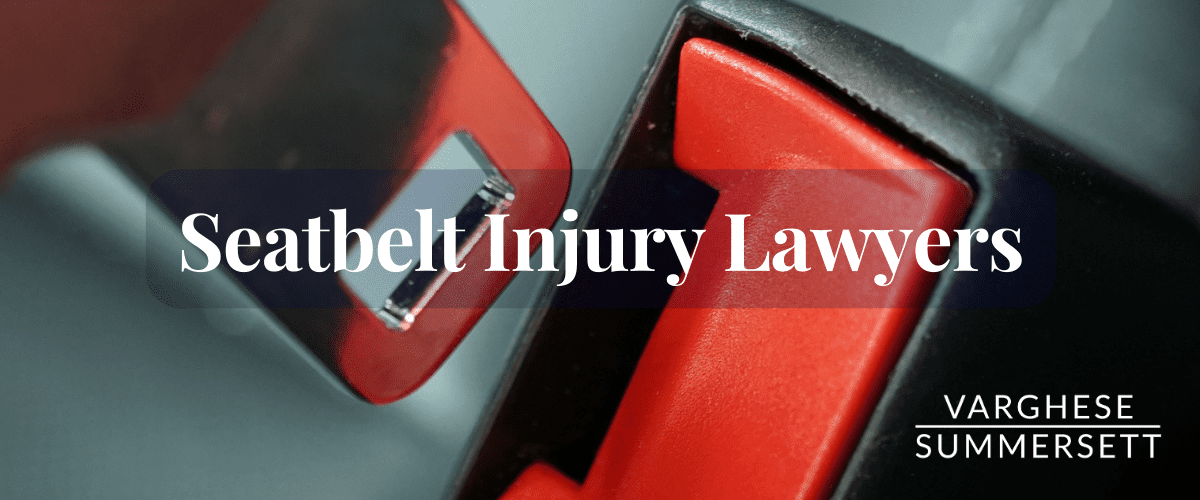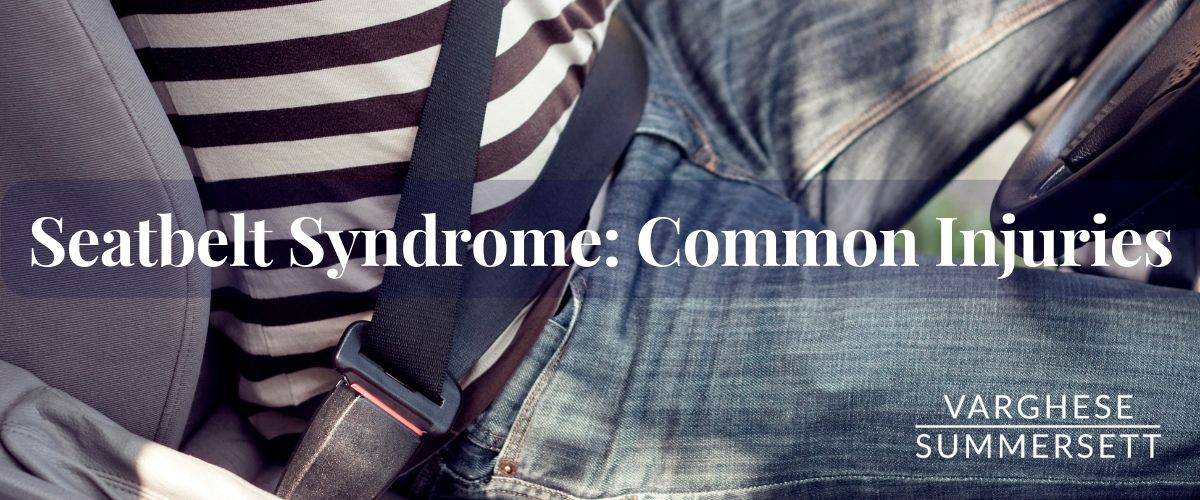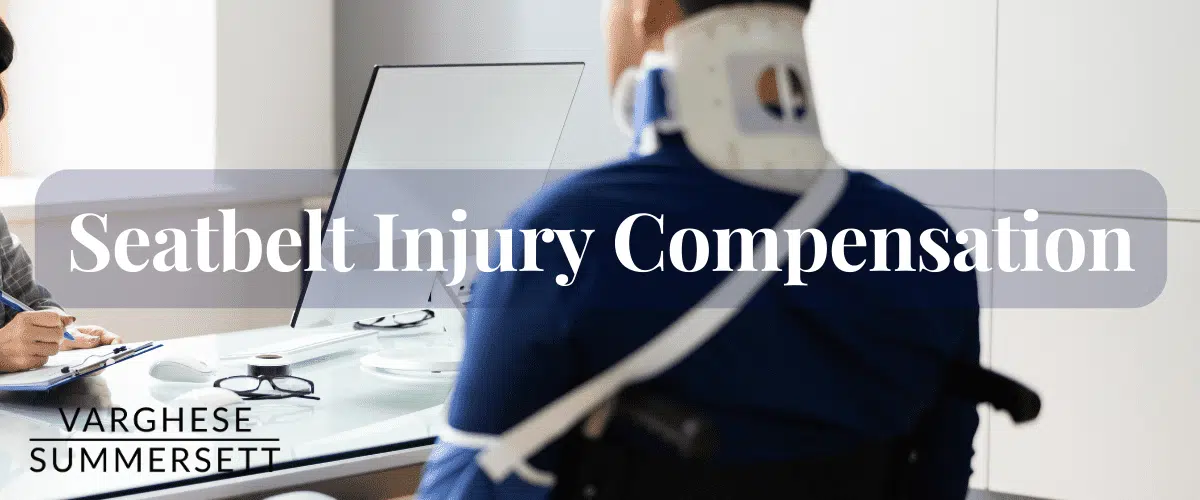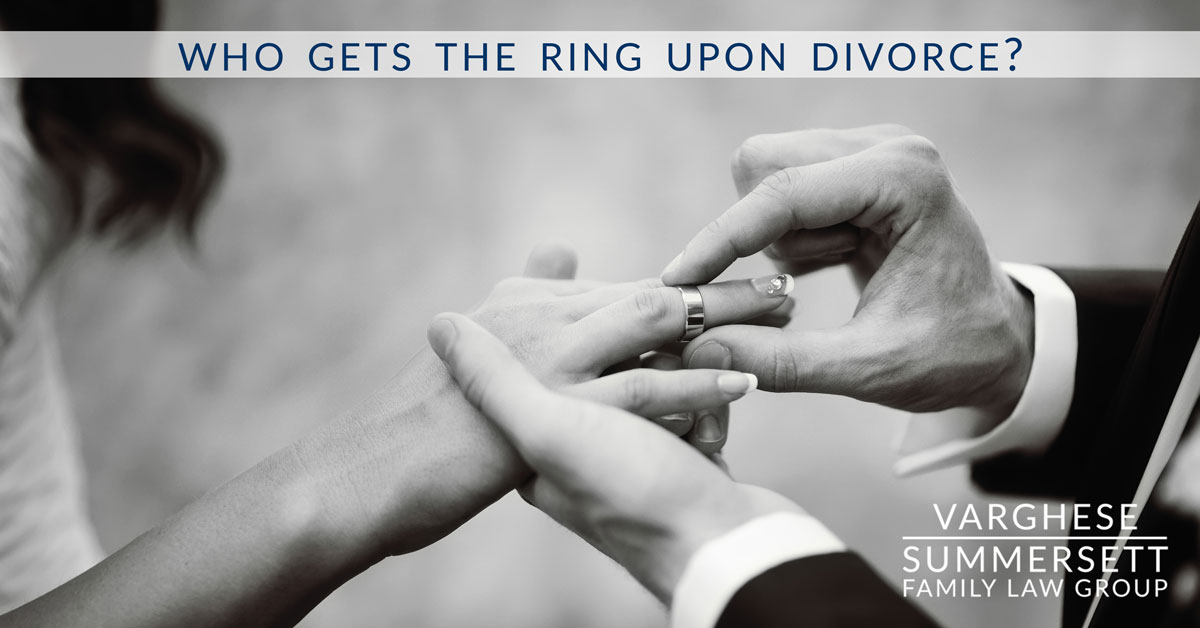
Fort Worth Seatbelt Injury Lawyer
Seatbelts are a vital safety feature in every vehicle, designed to protect drivers and passengers in the event of a collision. However, seatbelts can also cause serious, sometimes catastrophic, injuries. In some cases, seatbelts may be defective or malfunction but, even when they work as intended, they can often cause secondary injuries.
By way of example, you may recall in 2016, Toyota recalled nearly 3 million RAV4s after seatbelt separations caused 10 deaths and more than 100 injuries. In 2023, Honda recalled half a million vehicles over seatbelts that were not properly latching.
If you or a loved one has been seriously injured in a car wreck by a faulty seatbelt or received secondary injuries in a wreck caused by another driver, you may be entitled to financial compensation. Our Fort Worth seatbelt lawyer at Varghese Summersett Injury Law Group can assess your case and determine if you have a valid claim for seatbelt injury compensation.
In this article, our Fort Worth seatbelt lawyer explains seatbelt injuries, the process for recovering compensation, and how our law firm can help. We offer free consultations and, if we take your case, we only get paid if and when recover compensation. You will never pay anything upfront or out-of-pocket.

Seatbelt Syndrome: Common Types of Seatbelt Injuries
Seat belt injuries are so common and specific that there is a term for it: seatbelt syndrome. Seatbelt syndrome refers to a combination of injuries that are caused by seatbelts during a vehicle collision. Seat belt syndrome typically involves injuries to the abdomen, chest, and spine. Injuries associated with seat belt syndrome include:
Abdominal injuries
The force exerted by the lap belt during a collision can cause bruising, lacerations, or rupture of the abdominal organs, such as the spleen, liver, or intestines. In some cases, the pressure on the abdomen can also lead to injury to major blood vessels, causing internal bleeding.
Chest injuries
The shoulder strap of the seat belt can exert force on the chest, potentially causing contusions, rib fractures, or injuries to the lungs or heart. In severe cases, the pressure from the shoulder strap can lead to a collapsed lung or traumatic cardiac injury.
Spinal injuries
Seat belt syndrome can also cause injuries to the spine, particularly in the lumbar and thoracic regions. The sudden deceleration during a collision can lead to compression and flexion injuries, which can result in fractures, dislocations, or damage to the spinal cord.
Soft tissue injuries
The force of the seat belt on the body can cause bruises, abrasions, or lacerations to the skin and underlying tissues. These injuries may be more pronounced if the seatbelt is not positioned correctly or is too tight.
To minimize the risk of seat belt syndrome, seat belts must be worn correctly. The lap belt should be positioned low across the hips, and the shoulder strap should be across the chest without cutting into the neck. Proper positioning and use of seat belts can help reduce the severity of injuries in the event of a car accident.
Seatbelt Malfunction and Defects: Product Liability
Seatbelts are designed to save lives, but when they don’t work as intended, serious injury or death can occur. Cases involving a defective seatbelt fall under the category of product liability, which holds manufacturers and designers responsible for any injuries caused by a defective or malfunctioning product. Seatbelt malfunctions can be the result of manufacturing defects, design flaws, or wear and tear.
For example, the National Traffic Highway Safety Administration is currently investigating Tesla Model X seatbelt failures after vehicle owners complained that their front safety belt failed to stay connected to the seat belt anchor pretensioner while driving. While no injuries were reported, up to 50,000 vehicles may be affected. This illustrates how common – and serious – seatbelt defects can be.
Common seatbelt defects include:
Frayed or torn webbing
The seatbelt webbing can become frayed or torn due to wear and tear, which can weaken the belt and make it less effective in the event of an accident.
Damaged buckles
The seatbelt buckle can become damaged or worn out, making it difficult to fasten or latch, causing it to come undone during an accident.
Broken retractor mechanism
The retractor mechanism that allows the seatbelt to retract can break or malfunction, making it difficult to properly secure the seatbelt.
Twisted or tangled webbing
The seatbelt webbing can become twisted or tangled, which can prevent the belt from properly restraining the occupant in the event of an accident.
Inadequate anchorage points
The seatbelt anchorage points can be improperly installed or designed, which can reduce the effectiveness of the seatbelt in the event of an accident.
Spooling
Spooling occurs when an excessive amount of the seat belt feeds out and there is too much belt to adequately restrain the passenger. This can result in serious or fatal injuries during a wreck.
A Fort Worth seatbelt injury lawyer with our firm can discuss the specifics of your case to ascertain if you have a product liability case or who is responsible for your seatbelt injuries. We have extensive experience handling product liability cases, and we will fight to ensure that you receive the compensation you deserve for your injuries.
Texas Seatbelt Law
Adult seatbelt requirements
Under Texas law, all adult drivers and passengers are required to wear a seatbelt. It doesn’t matter how old they are or where they are seated in the vehicle, everyone has to buckle up.
Child seat belt and car seat requirement
Texas law mandates that all children under the age of 8, unless they are taller than 4 feet 9 inches, must be in an appropriate child safety seat system based on their age, weight, and height. The child safety seat must be installed according to the manufacturer’s instructions and comply with federal standards.
Primary enforcement law
Texas has a primary seat belt law, which means that a law enforcement officer can stop and ticket a driver solely for not wearing a seat belt or not having a child properly restrained in a car seat. Violating Texas seat belt laws can result in fines ranging up to $250, plus court costs. For child safety seat violations, the driver may also be required to attend a court-ordered child safety seat course.
Exceptions
Some exceptions to Texas seat belt laws include vehicles not required to have seat belts (such as certain vintage cars), rural mail carriers while delivering mail, and people with a medical condition or disability that prevents the use of a seat belt (a written statement from a physician is required).

Seatbelt Injury Compensation: Possible Damages
Compensation for seatbelt injuries can include damages for medical expenses, lost wages, pain and suffering, and more. A Fort Worth seatbelt injury lawyer can help determine the appropriate compensation for your case, which could include economic, non-economic and punitive damages. Each type of damage serves a different purpose and is meant to compensate the injured party or penalize the wrongdoer. Here’s a brief overview of each category:
Economic damages
These damages refer to the quantifiable financial losses incurred as a result of the injury. They include medical expenses, lost wages, loss of earning capacity, and property damage. Economic damages are intended to compensate the injured party for the financial impact of the injury and help restore them to the financial position they were in before the injury occurred.
Non-economic damages
Non-economic damages are more subjective in nature and aim to compensate the injured party for the intangible losses that they suffer. These damages can include pain and suffering, emotional distress, loss of enjoyment of life, and loss of consortium (the loss of companionship, support, and intimacy experienced by a spouse or family member). Non-economic damages are more difficult to quantify, as they vary greatly from case to case and depend on the individual circumstances of the injured party.
Punitive damages
Unlike economic and non-economic damages, punitive damages are not meant to compensate the injured party. Instead, they are intended to punish the wrongdoer for particularly egregious or malicious conduct and serve as a deterrent to others from engaging in similar behavior. In Texas, punitive damages are also known as “exemplary damages.” They are not awarded in every case and have specific criteria that must be met, such as proving that the wrongdoer acted with gross negligence, malice, or fraud.
It is important to consult with an experienced Fort Worth seatbelt injury lawyer to assess the potential damages in a Texas injury case and navigate the complexities of the legal process.
Seatbelt Injury Claims Process: 5 Steps
If you or a loved one has sustained injuries due to a seatbelt, it’s important, at a minimum, to follow these five steps to put yourself in the best position for a successful seatbelt injury claim.
- Seek Medical Attention
If you have been involved in an accident and have suffered injuries, seek medical attention immediately. Your health and safety should always be your top priority. - Document Scene & Injuries
Take photos of the accident scene and gather witness information if possible. Keep a record of all injuries sustained as a result of the accident, including any injuries caused by your seatbelt. Take photographs of any visible injuries and keep copies of all medical records and bills. - Call an Experienced Personal Injury Attorney
If you believe that you have a valid claim for seatbelt injury, it’s important to consult an attorney who specializes in personal injury law and has handled seatbelt injury cases. They can advise you on the strength of your case and help you navigate the claims process. - File a Claim: If your attorney thinks you have a case, he or she can file a claim against the negligent party or parties involved in the accident. During this phase of the process, it’s important to listen to your attorney. Do not try and negotiate with the insurance company yourself. In fact, it’s best to leave all communication with the insurance companies to your attorney.
- Litigation: If the insurance company doesn’t offer a fair settlement after negotiating, then we will take it to trial. Your attorney will represent you in court and fight to get you the maximum compensation.
How Varghese Summersett Can Help
If you were injured or a loved one died due to a seatbelt injury in Fort Worth, Dallas or the surrounding area, it’s important to speak with a Fort Worth seatbelt injury lawyer as soon as possible. This is how the attorneys and team at Varghese Summersett can help:
Free Consultation
We will listen to the facts and circumstances of your case and advise you on the best course of action to take after a seatbelt injury. We will evaluate the strength of your case, explain potential outcomes, and help you determine whether to pursue a claim for compensation.
Investigation
We will thoroughly investigate the circumstances of the accident and determine every person or entity that bears any responsibility or liability. This may involve reviewing police reports, medical reports and witness statements, as well as consulting with accident reconstruction experts.
Negotiation
We will negotiate with the insurance company or the negligent party on your behalf in an effort to secure a fair settlement for your injuries. If an agreement can’t be reached, we will fight for you in trial.
Compensation
We will do everything in our power to help you recover compensation for a range of damages, including medical expenses, lost wages, pain and suffering, and any other damages related to your seatbelt injury. We know you didn’t ask to be in this unfortunate situation and we will work to get your life back on track.
Speak to a Fort Worth Seatbelt Injury Lawyer Today.
Call now for a free consultation with a Fort Worth seatbelt injury lawyer and find out why we are the firm people turn to when they are facing life’s greatest challenges. Best of all, we will never add to your financial burden. We work on contingency, which means we only get paid after we win a settlement or verdict for you. We can be reached at 817-207-4878 (HURT) or contact us online.
FAQs About Seatbelt Injury Claims
What is seatbelt syndrome?
Seatbelt syndrome is a term that refers to a combination of injuries that can occur from wearing a seatbelt during a collision, including damage to the spine, abdominal organs, and blood vessels.
How long do I have to file a seat belt injury claim?
In Texas, the statute of limitations for filing a seatbelt injury claim is typically two years from the date of the accident. This means that you must file your claim within two years of the date of the accident, or you may lose your right to seek compensation for your injuries.
What is modified comparative negligence in Texas seatbelt cases?
Modified comparative negligence, also known as proportionate responsibility, is a legal principle applied in Texas personal injury cases, including seatbelt cases. Under this rule, an injured party’s compensation may be reduced in proportion to their percentage of fault for the accident or their injuries, as long as their fault does not exceed 50 percent.
In Texas seatbelt cases, if an injured party is found to be partially at fault for their injuries due to not wearing a seatbelt, their compensation may be reduced by the percentage of their fault. For example, if an injured party is found to be 20 percent at fault for their injuries because they did not wear a seatbelt, they may only recover 80 percent of the total damages awarded. However, if their fault exceeds 50 percent, they will not be able to recover any damages.
Texas law requires all drivers and passengers to wear seatbelts, and failure to do so can be used as evidence of negligence in a personal injury claim. A Fort Worth seatbelt injury lawyer can help navigate the complexities of Texas seatbelt laws and modified comparative negligence when seeking compensation for injuries sustained in a car accident.
What is a seatbelt sign injury?
A seat belt sign injury refers to a specific pattern of bruising, abrasions, or other visible skin injuries caused by the use of a seat belt during a motor vehicle accident. The seat belt sign is usually seen across the chest, abdomen, or shoulder where the seat belt made contact with the body during the accident.
While seat belts play a crucial role in reducing the severity of injuries and saving lives in car crashes, they can also cause injuries themselves due to the force exerted on the body during a collision. The presence of a seat belt sign injury can indicate that the person was wearing a seat belt at the time of the accident, and it may also suggest the possibility of underlying internal injuries, such as organ damage or internal bleeding.
If a seat belt sign injury is observed, it is essential for medical professionals to carefully evaluate the affected individual for potential internal injuries, as these may not be immediately apparent but can have severe consequences if left untreated.
Can someone be held liable if my seatbelt broke?
Generally, there are a few parties that could potentially be held liable:
- Vehicle manufacturer: If the seatbelt malfunction is due to a defect in the design or manufacturing process, the vehicle manufacturer could be held responsible under product liability laws.
- Seatbelt manufacturer: If the seatbelt itself was manufactured by a different company than the vehicle, that company could also be held liable for defects in the seatbelt.
- Maintenance or repair shop: If the seatbelt malfunctioned due to improper maintenance or repair work done on the vehicle, the party responsible for those services might be held liable for any resulting damages.
- Vehicle owner or operator: If the seatbelt malfunctioned due to the owner or operator’s negligence (e.g., failing to maintain the seatbelt or knowingly using a faulty seatbelt), they could potentially be held responsible.
In any of these scenarios, determining liability requires the assistance of an experienced attorney who specializes in personal injury or product liability. The Fort Worth seatbelt injury lawyers at Varghese Summersett can help.



